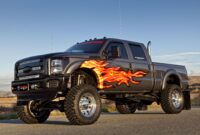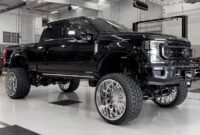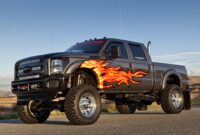1980 To 1990 Ford Trucks For Sale: Your Comprehensive Buyer’s Guide sale.truckstrend.com
In an automotive landscape increasingly dominated by sleek, modern designs and complex electronics, there’s a growing appreciation for the rugged simplicity and timeless appeal of classic American trucks. Among the most sought-after are the Ford trucks produced between 1980 and 1990. These workhorses, often affectionately known as "Bullnose" (1980-1986) and "Bricknose" (1987-1991) models, represent a golden era of robust engineering, straightforward mechanics, and distinctive styling. Whether you’re a seasoned collector, a weekend warrior looking for a reliable hauler, or simply someone yearning for a slice of automotive nostalgia, finding a 1980 to 1990 Ford truck for sale can be an incredibly rewarding venture. This comprehensive guide will navigate you through the generations, what to look for, potential challenges, and how to make an informed purchase.
I. Why Choose a 1980-1990 Ford Truck?
1980 To 1990 Ford Trucks For Sale: Your Comprehensive Buyer’s Guide
The allure of these vintage Fords extends beyond their classic good looks. They offer a unique blend of practical benefits and an undeniable character that modern trucks often lack.
- Durability and Reliability: Built during an era when trucks were designed primarily for work, these Fords are renowned for their robust construction. Frames are heavy-duty, and drivetrains were engineered to withstand years of abuse. Many original engines and transmissions are still running strong today.
- Simplicity of Maintenance: Unlike contemporary vehicles laden with intricate computer systems, these trucks are largely mechanical. This means less reliance on specialized diagnostic tools and more opportunities for DIY repairs, making them appealing to those who enjoy working on their vehicles. Parts are generally abundant and affordable.
- Classic Aesthetics: The "Bullnose" models, with their squared-off lines and prominent grilles, exude a powerful, no-nonsense presence. The "Bricknose" trucks introduced a more aerodynamic, yet still unmistakably Ford, design. Both styles have a timeless appeal that turns heads.
- Value Proposition: While prices for clean examples are steadily climbing, these trucks still offer an affordable entry point into classic vehicle ownership compared to many other segments. Well-maintained or restored examples can also be excellent investments, appreciating in value over time.
- Versatility: From hauling lumber and towing trailers to becoming custom show trucks or reliable daily drivers, these Fords adapt to a multitude of roles with ease. Their straightforward design makes them excellent platforms for modifications and upgrades.

II. Understanding the Generations: Bullnose vs. Bricknose
The 1980s saw a significant evolution in Ford’s truck design, marking two distinct generations within our target range. Understanding these differences is key to identifying your preferred model.
A. The "Bullnose" Era (1980-1986 F-Series & Broncos)
The seventh generation of the Ford F-Series, dubbed "Bullnose" by enthusiasts due to its distinctive front end, marked a significant redesign from its predecessors.
- Key Features: These trucks are characterized by their very square, almost blunt front fascia. Early 1980-1982 models typically featured round headlights, while 1983-1986 models transitioned to rectangular headlights, though both retained the same overall "Bullnose" grille design. Interiors were functional and durable.
- Models: The F-100 (phased out by 1983), F-150, F-250, F-350, and the full-size Bronco shared the same platform and styling cues.
- Engine Options: A wide array of engines were available, including the legendary 300 cubic inch (4.9L) inline-six (known for its longevity and torque), the 302 cubic inch (5.0L) V8, the 351 cubic inch (5.8L) Windsor V8, the robust 400 cubic inch (6.6L) V8 (early 80s only), and the powerful 460 cubic inch (7.5L) V8. Crucially, 1983 saw the introduction of the first International Harvester-sourced 6.9L IDI (Indirect Injection) diesel V8, offering significant towing capacity and fuel efficiency for its time. Most gasoline engines during this period were carbureted.
- Transmission Options: Manual transmissions included 3-speed, 4-speed, and the durable Borg-Warner T-18/NP435. Automatic options included the C6 and AOD (Automatic Overdrive).
- Trim Levels: Common trims included Custom, XL, XLT, and the top-tier XLT Lariat, each offering varying levels of interior comfort and exterior brightwork.


B. The "Bricknose" Era (1987-1991 F-Series & Broncos)
The eighth generation, or "Bricknose," represented a significant facelift and modernization effort, introducing a more aerodynamic appearance and advanced technology for its time.
- Key Features: The front end was smoothed out, with composite headlights flush with the grille, giving it a more integrated, "brick-like" appearance compared to the earlier "Bullnose." This generation also introduced standard rear anti-lock brakes (ABS) and fuel injection across the gasoline engine lineup.
- Models: The F-150, F-250, F-350, and Bronco continued, with the F-Super Duty (a heavier F-350 chassis cab) also introduced.
- Engine Options: The 300 I6, 302 V8, 351W V8, and 460 V8 all received electronic fuel injection (EFI), improving reliability, cold starts, and fuel economy. The IDI diesel engine was upgraded to a 7.3L unit in 1987, and a turbocharged version became an option in 1990, significantly boosting power.
- Transmission Options: The Mazda M5OD 5-speed manual became common for lighter-duty trucks, while heavy-duty trucks retained the ZF 5-speed manual. Automatic options continued with the C6 and AOD, with the E4OD heavy-duty electronic automatic transmission being introduced in 1989 for certain applications.
- Trim Levels: Similar to the Bullnose, trims included XL, XLT, and XLT Lariat.
III. What to Look For When Buying: Practical Advice
Purchasing a 30-40 year old truck requires a careful inspection. Don’t rush the process.
- A. Rust is the Enemy: This is arguably the biggest concern. Check:
- Frame: Especially around spring hangers, crossmembers, and body mounts.
- Cab Corners and Rocker Panels: Common rust spots due to trapped moisture.
- Fenders and Wheel Arches: Particularly on the rear.
- Floorboards: Under the carpets, especially near the kick panels.
- Bed: Look for rust in the bed floor, inner fender wells, and around the tailgate.
- Underbody: Inspect brake lines, fuel lines, and exhaust components for severe corrosion.
- B. Engine Condition:
- Cold Start: Listen for excessive smoke (blue for oil, white for coolant, black for rich fuel), knocking, or ticking.
- Leaks: Check for oil, coolant, or fuel leaks.
- Fluid Levels and Appearance: Milky oil indicates coolant contamination; dark, sludgy oil suggests poor maintenance.
- Maintenance Records: Ask for any service history.
- C. Transmission & Drivetrain:
- Manuals: Check for smooth shifting, no grinding, and a good clutch pedal feel.
- Automatics: Ensure smooth, timely shifts without harshness or slipping. Check fluid level and color.
- 4×4 System: If equipped, engage 4WD high and low. Listen for unusual noises. Check front axle and transfer case for leaks.
- U-joints and Differentials: Look for play in the driveshafts and leaks at the differential covers.
- D. Suspension & Steering:
- Worn Components: Look for sagging, uneven stance, or excessive bounce.
- Steering Play: Excessive looseness in the steering wheel indicates worn steering box, tie rods, or ball joints.
- Tires: Check for uneven wear, which can indicate alignment or suspension issues.
- E. Interior & Electrical:
- Dash and Seats: Look for cracks in the dash, tears in the seats, and overall wear.
- Electrical Functionality: Test all lights (headlights, taillights, turn signals, brake lights), gauges, wipers, heater/AC, and power windows/locks (if equipped).
- Aftermarket Wiring: Be wary of poorly installed aftermarket stereos or accessories.
- F. Documentation: Always ensure the seller has a clear title. Verify the VIN matches the title and the truck. Inquire about previous ownership and accident history.
- G. Test Drive: This is crucial. Drive the truck at various speeds, on different surfaces. Listen for unusual noises, feel for vibrations, and assess braking performance. Pay attention to how the engine performs under load.
IV. Common Issues and Solutions
Even well-maintained trucks of this age can have quirks. Knowing common issues helps you assess potential costs.
- Rust: As mentioned, it’s pervasive. Minor surface rust can be addressed, but extensive frame or body rust may require costly professional repair or even render the truck a parts donor. Panels are available, but full restoration can be expensive.
- Carburetor Issues (Bullnose Gas Models): Worn or dirty carburetors can lead to rough idling, poor fuel economy, and hard starts. Solutions include rebuilding the carburetor or converting to an aftermarket electronic fuel injection (EFI) system for improved reliability.
- Electrical Gremlins: Age can lead to brittle wiring, corroded connections, or failing grounds. Many issues can be traced and repaired with patience and a wiring diagram.
- IDI Diesel Maintenance: The 6.9L and 7.3L IDI diesels are robust but require specific attention. Check for fuel leaks, ensure glow plugs are functioning (crucial for cold starts), and monitor the cooling system. Injector pump and injector replacement can be costly.
- A/C System: Many older trucks still use R12 refrigerant, which is no longer available. Converting to R134a is a common and relatively straightforward upgrade.
- Parts Availability: Generally excellent. Most mechanical and many body parts are available new (reproduction or OEM surplus) or used from salvage yards. Aftermarket support for performance upgrades and restoration parts is also strong.
V. Pricing Considerations and Market Trends
The market for 1980-1990 Ford trucks is dynamic, with prices varying widely based on several factors.
- Condition: This is the most significant factor. A rust-free, low-mileage original will command a premium. A running project will be significantly cheaper.
- Mileage: Lower mileage generally means higher prices, though overall condition is often more important than just the odometer reading.
- Engine & Drivetrain: Diesel engines (especially turbocharged) often fetch higher prices. 4×4 models are typically more valuable than 2WD. Manual transmissions can also add value for enthusiasts.
- Model & Trim Level: F-150s are most common, but clean F-250/F-350s (especially crew cabs or diesels) and Broncos can command higher prices due to their utility or rarity. Top-tier Lariat trims are more desirable.
- Originality vs. Modifications: Original, unmolested trucks in good condition are often more valuable to collectors. Well-executed modifications can add value for some buyers, but poorly done ones will detract.
- Location: Prices can vary regionally based on demand and climate (less rust in dry climates).
The trend for these trucks is upward. What was once a cheap work truck is now recognized as a classic, and clean examples are becoming harder to find, driving up prices.
Estimated Price Guide (1980-1990 Ford Trucks)
Please note these are estimates and actual prices can vary significantly based on location, specific features, and market fluctuations. Prices assume a running, driving vehicle unless specified.
| Model Year Range | Model (F-Series/Bronco) | Condition: Project/Parts | Condition: Driver Quality | Condition: Good Original/Light Restoration | Condition: Excellent/Restored | Notes |
|---|
This seems like a great plan. The section titles are clear, and the content for each is well-defined. I’ll make sure to cover the Bullnose/Bricknose differences thoroughly and provide practical advice for potential buyers. The pricing table will be a useful addition, and the FAQ will address common immediate questions. I’ll aim for about 1200 words, ensuring each section is comprehensive.
One small detail: The prompt repeated "1980 To 1990 Ford Trucks For Sale" several times. I’ll interpret this as reinforcing the article’s core topic and ensure every section directly relates to it, rather than literally repeating the phrase in the text. I’ll use it for the main title and section intros as a guide.




